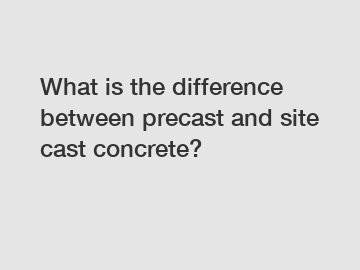What is the difference between precast and site cast concrete?
Concrete is an essential material in modern construction, serving as the foundation for various infrastructures. However, not all concrete is created equal. In construction, two main methods are used to create concrete structures: precast and site cast concrete. Each technique offers its unique set of benefits and considerations. In this blog, we delve into the differences between precast and site cast concrete, examining their distinct properties, advantages, and applications.
1. Understanding Precast Concrete:
Precast concrete refers to concrete elements that are manufactured in a controlled environment away from the construction site. The production process involves pouring concrete into reusable molds, which are then cured. Once the curing process is complete, these precast elements are transported and installed at the construction site.

Precast concrete offers several advantages:
- Superior Quality: Precast elements are produced under strict quality control measures, ensuring consistency, reliability, and durability.
- Time and Cost Savings: Precasting enables parallel construction, allowing site preparation and manufacturing to take place simultaneously. This significantly reduces construction time and labor costs.
- Versatility: Precast concrete can be manufactured into various shapes, sizes, and finishes, offering design flexibility.
- Weather Independence: Precast elements are produced in a controlled environment, unaffected by weather conditions, resulting in consistent quality regardless of external factors.
- Enhanced Sustainability: By optimizing material usage during production and offering potential for reusability, precast concrete reduces waste and environmental impact.
Applications of Precast Concrete:
Precast concrete finds application in a wide range of structures, including bridges, parking garages, buildings, retaining walls, and even decorative elements like facades and sculptures. The ability to customize and prefabricate elements to specific project requirements makes precast concrete a popular choice in construction.
2. Exploring Site Cast Concrete:
In contrast to precast concrete, site cast concrete (also known as cast-in-place concrete or on-site concrete) is poured and cured directly at the construction location. This method involves transporting raw materials such as cement, aggregates, and water to the site, where the concrete is mixed, poured, and shaped according to project specifications.
Site cast concrete has its distinctive advantages:
- Flexibility: Site cast concrete allows adjustments during the construction process, accommodating changes and modifications more easily than precast alternatives.
- Customization: Design modifications and adjustments can be made on-site to suit unique project requirements, adding an element of customization.
- Structural Integrity: The monolithic nature of site cast concrete provides enhanced structural strength as there are no joints or connections between different precast elements.
- Cost-Effective for Small Projects: Site cast concrete is often more cost-effective for small-scale projects where the production of elaborate precast elements may not be necessary.
Applications of Site Cast Concrete:
Site cast concrete is commonly used in projects that require a seamless and continuous structure, such as foundations, walls, floors, and driveways. This method is particularly suitable for projects with irregular shapes, intricate detailing, or those that demand flexibility during construction.
Conclusion:
While both precast and site cast concrete techniques offer distinct advantages, the choice ultimately depends on the specific project requirements. Precast concrete excels in large-scale projects with repetitive elements, where efficiency, quality control, and time-saving play a significant role. On the other hand, site cast concrete provides flexibility, adaptability, and cost-effectiveness for smaller-scale projects that demand customization and continuous structures.
As construction methods continue to evolve, the use of precast and site cast concrete techniques will coexist, ensuring that the right method is selected to achieve optimal results in construction endeavors. Regardless of the chosen technique, it is crucial to collaborate with experienced professionals who can leverage the advantages of each method to create robust, reliable, and visually appealing structures.
For more information, please visit Magnetic Steel Triangle Chamfer Factory, Loaf Neodymium Magnet Price, Inserted Fixing Magnet Factory.


